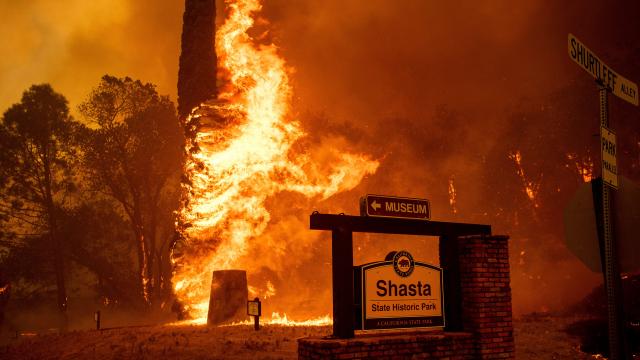In news that’s become all too common, a massive fire swept into a California city yesterday. Thirty-metre walls of flames and traffic jams created a nightmare scenario in and around Redding, California, a city of 90,000. Neighbourhoods and even entire surrounding towns have been evacuated, including a news station that stayed on the air until they were force to leave mid-broadcast.
In their update yesterday, CAL FIRE said that the hard work of nearly 1750 firefighters couldn’t contain the flames due to “extreme fire behaviour and unfavourable weather conditions”. As of midnight local time (5PM AEST), the fire ballooned 50 per cent overnight to 44,450 acres and was only three per cent contained.
“This fire is extremely dangerous and moving with no regard to what’s in its path,” CAL FIRE Chief Brett Gouvea said at a news conference yesterday.
Up until yesterday, most of the damage played out west of Redding, with the Sacramento River acting as a buffer between the city and the flames. Residents there have seen signs of the fire for days as it whipped up smoke and towering pyrocumulus clouds, as well as news reports of its trail of destruction.
But yesterday, Thursday night in California, the fire jumped the river, sparking an evacuation of the neighbourhoods on the western edge of town that caused bumper-to-bumper traffic. Around 2:30AM local time (7:30PM AEST), CAL FIRE also issued a mandatory evacuation for Shasta Lake City, a town of 9000 on the northern edge of Redding.
Update: units reporting a 100 foot wall of flame coming down on Snow Lane in #Redding. Extremely erratic fire conditions being reported. #Carrfire #Breaking
— Bernie Deyo (@EPN473) July 27, 2018
As fire started to rampage through the neighbourhoods, firefighters stopped their containment efforts and began doing everything they could to get residents to safety.
Local news report indicate that entire neighbourhoods were ablaze. CAL FIRE is reporting that only 15 structures have been destroyed and another five have been damaged, but those numbers will surely rise as the sun comes up on the Redding area and firefighters begin to assess the damage.
There has also been at least one fatality (a bulldozer operator who was working to contain the fire). That number that may unfortunately rise given the speed with which the fire tore into town.
KRCR, the local NBC affiliate, was in one of the mandatory evacuation zones. Visibly uneasy anchors signed off, saying, “We are going to leave the station because it is now unsafe to be here,” as they cut to the station’s webcam showing the quintessential suburban view of street lights and trees lit by the bright glow of fire burning in the night.
HAPPENING NOW: @KRCR7 is evacuating as the #CarrFire approaches their studio in #Redding, California. Horrible.
Stay safe out there. pic.twitter.com/LRfRoVIdDI— Nick Stewart (@NStewCBS2) July 27, 2018
A scorching heat wave has helped create such dangerous conditions. Temperatures reached 44C in Redding yesterday and are forecast stay above 43C all weekend. The 10-day forecast shows 38C+ heat is likely to continue throughout next week. The heat, coupled with the moderate drought gripping the western portion of Shasta County, is a potent combination.
But the fire has burned so intensely that it also appears to have created its own weather, as the heat from the flames rises and stirs the atmosphere.
Towering pyrocumulus clouds, basically fire-driven thunderstorms, were clearly visible on satellite images during the day. The powerful winds that come along with those clouds likely spurred the Carr Fire on over dried-out brush and forest.
The fire is one of three large blazes that have lit up California. The Cranston Fire continues to burn largely out of control about 160km southeast of Los Angeles, while the Ferguson Fire forced Yosemite National Park to evacuate visitors for the first time in decades. They come a year after the state had both its most destructive and largest bushfires ever recorded.
The major blazes are a reminder that we’re living in a changed climate that’s increasing the odds of bushfire conditions. Bushfire season in the US West is now 105 days longer than it was in the 1970s, and large fires are becoming more common, according to research by Climate Central (full disclosure: I used to work there).
Climate change is responsible for half of the uptick in fires from 1984 to 2015, according to a 2016 study. In California in particular, recent research shows that precipitation in spring and autumn — the shoulder seasons to California’s wet winter — is likely to dry up, further lengthening bushfire season.
All this is happening as more people move into bushfire-prone areas, raising the risks of devastating consequences like the ones playing out in Redding. And it’s of course why we need to start preparing now for more intense urban fires.
